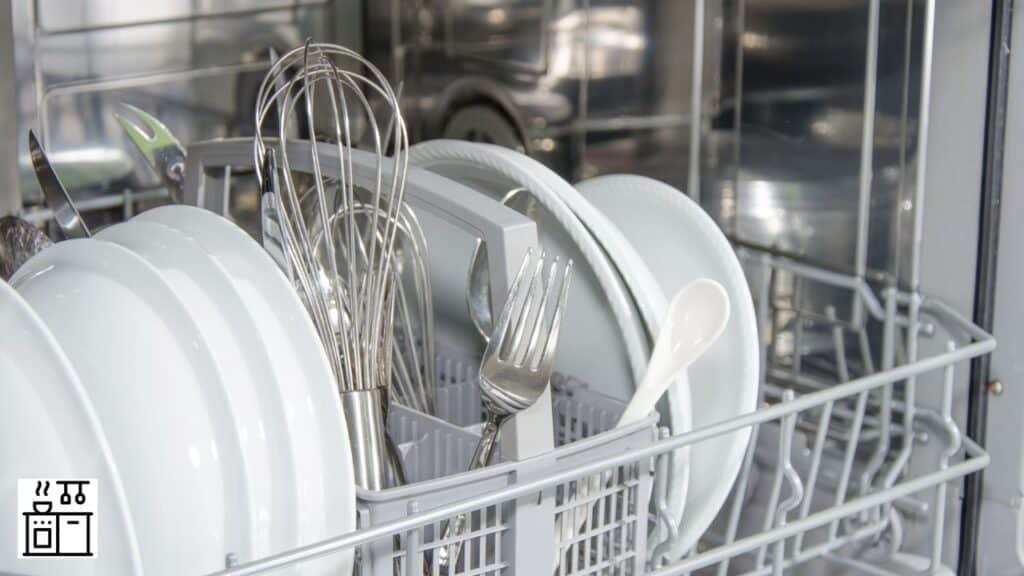A dishwasher is a machine that washes utensils in three simple steps; placing the dirty dishes inside the machine, adding detergent, and selecting the wash setting.
Understanding the working of this machine will help you get the most out of it.
Let’s explore this in closer detail.
Important Parts of A Dishwasher
We discussed the sequence of operations in a dishwasher cycle. Though it looks simple, it involves a lot of technology.
A dishwasher has many complicated systems and control circuitry that ensures the smooth functioning of the device.
Let’s look at the main parts.
Dishwasher Control Mechanism
The complex control circuitry of a dishwasher contains many electronic components.
Basic dishwashers use a simple electro-mechanical circuit with a timer and control mechanism.
The timer decides the length of the cycle, and the circuit activates the functions at the specified time. Advanced systems use computerized controls.
The control circuit is usually carefully isolated so it’s not affected by water or heat. The control system also has a thermostat to regulate water temperature.
Inlet Valve and Pump
This is the section of the dishwasher through which water enters. It’s an internal valve that opens to allow water and shuts when the device is loaded to the required level.
The other important part of a dishwasher is the circulation pump.
The main function of this pump is to force water into the spray arms during the operational cycle.
During the drain cycle, the same pump will direct water toward the drain hose.
Spray Arms
These are the rotating arms located at the bottom and top of the dishwasher. They spray water and detergent onto the dishes to remove food particles and debris.
Filters
The filters trap food particles and debris during the wash cycle. This helps to prevent the system from clogging.
Heating Element
The heating element is usually located at the bottom of the dishwasher. It heats the water during the wash cycle.
Hot water is used to remove grease and grime from dishes effectively.
Detergent Dispenser
This is where you add dishwasher detergent. The dispenser releases the detergent at the appropriate time during the wash cycle.
Drain Pump
The drain pump removes dirty water from the dishwasher at the end of the wash and rinse cycles.
Door
The door is the front panel of the dishwasher that you open and close to load and unload dishes. It also prevents water from leaking out during the wash cycle.
Racks
Dishwashers have two or more racks to hold dishes, plates, cups, glasses, and utensils in place during the wash cycle.
How Does a Dishwasher Operate?
A dishwasher is comparable to a washing machine that washes dirty clothes.
Being a robotic device, you can program a dishwasher to clean dirty dishes, dry them, and make them usable again.
Here are the different steps of operation.
1. Load the Dishes
This is a manual task. A dishwasher has multiple racks to hold utensils and cutlery.
Though you can load a dishwasher in any fashion, there are a few ways to ensure that the dishes become cleaner. They include:
- Placing the dishes with their faces toward the center,
- Angling the dishes downward,
- Avoid crowding the dishes. Leave enough space between each dish to be sprayed with water and soap,
- Placing dishes between the wires, and not over them,
- Avoid blocking the sprayer arms. They should be able to move freely to spread the water jets in all directions,
- Always ensure an item is dishwasher-safe before placing it in the dishwasher.
While loading the dishwasher, you should also add the dishwashing detergent to the detergent compartment.
2. Choose the Right Setting

Dishwashers have multiple settings to choose from. Choose the cycle based on the type of load and how heavy it is.
For quick washing, choose a quick cycle for fewer utensils. But for heavy and dirty dishes, opt for a heavy cycle.
Apart from these options, modern dishwashers also have automatic or sensor cycles, where sensors evaluate the load and automatically set the cycle.
Dishwasher cycles can range from half an hour to two hours or more, based on the setting.
Although a dishwasher may have a long cycle, it doesn’t mean that it uses too much water or power.
Modern dishwashers are designed for optimum water and power usage but longer cycles for thorough cleaning.
3. Heating of Water to The Appropriate Temperature
Dishwashers use hot water to clean and sanitize dishes properly. Depending on the setting, the water starts increasing to the required temperature.
There are internal sensors that determine when the desired temperature is reached. At this stage, the heating stops, and the device starts the cleaning process.
4. Detergent Dispersal
The next stage is to dispense the detergent into the dirty dishes from the detergent compartment. The dishwashing detergent can be liquid, powder, or tablet.
Any of these can be loaded into the detergent compartment. When the detergent compartment is opened, the detergent is dispensed into the dishes.
5. Water Is Sprayed Through the Spray Arms
Once the detergent is dispensed, the next step is to spray water on the dirty dishes.
The spray arms are rotating structures that spray water in different directions. They ensure that all the dirty dishes are covered with soap and water by spreading water throughout the compartment.
For efficient spraying, the spray arms should not be blocked, and their movement should not be restricted.
The residual food and grease on the utensils will thus be dislodged from the utensils.
6. Dirty Water Drains out Of the Compartment
The dirty water containing the residual food and grease will now flow down into the drain compartment and move into the outlet.
When food particles are washed off the dishes, they are either caught by a filter or broken down into tiny pieces that will not block the plumbing system.
This action is similar to a garbage disposal. The water filters through into the drain through the dishwasher outlet.
7. The Process Repeats
Depending on the cycle setting, the spraying arms will repeatedly spray water on the dishes and continue to clean them several times.
This continuous wash and rinse process gets all the food residue out of the dishes. The dirty water continues to flow into the outlet and into the plumbing system.
8. The Dishes Are Dried Using Hot Air
The final step is drying the dishes. In most dishwashers, it’s not a default setting. So you should enable this function.
If the user selects this setting, the dishwasher will blast hot air into the dish compartment.
The hot air will make the water droplets evaporate and dry the dishes. Heat will also sanitize the dishes thoroughly.
What Happens During a Dishwasher Cycle?
A dishwasher’s cleaning cycle has three parts:
Pre-Wash/rinse
During the pre-wash stage, a burst of water is sprayed on all the dishes. This makes them wet throughout.
The force of the water also helps to dislodge any loose food bits on the dish surfaces.
Main Wash
This is the main part of the cycle where all the cleaning takes place. During this stage, the water is heated, sprayed, filtered, and repeated.
The cycle repeats multiple times during the main wash. Depending on the cycle setting chosen, it can take anywhere between 20 and 60 minutes to complete.
Final Wash and Rinse
By the end of the main wash, the dishes will be almost clean. Then, the final wash and rinse phase begins. New and clean water flows into the dishwasher.
The detergent may or may not be used, depending on the type of dishwasher.
The final rinse takes 20 to 60 minutes. During this time, the sprays work multiple times to clear all the remaining food residue from the dishes.
After this stage, the water is drained, and the dishes are ready for use.

